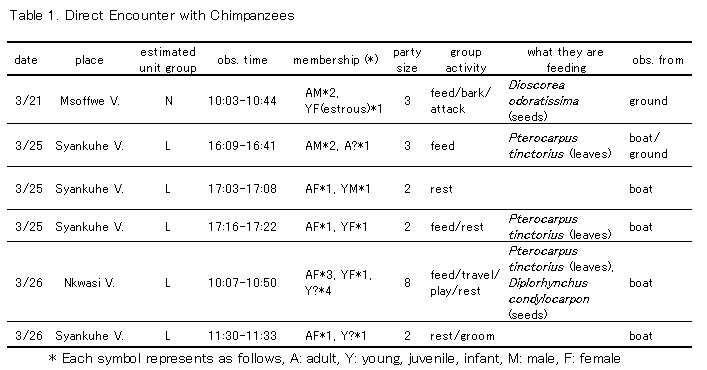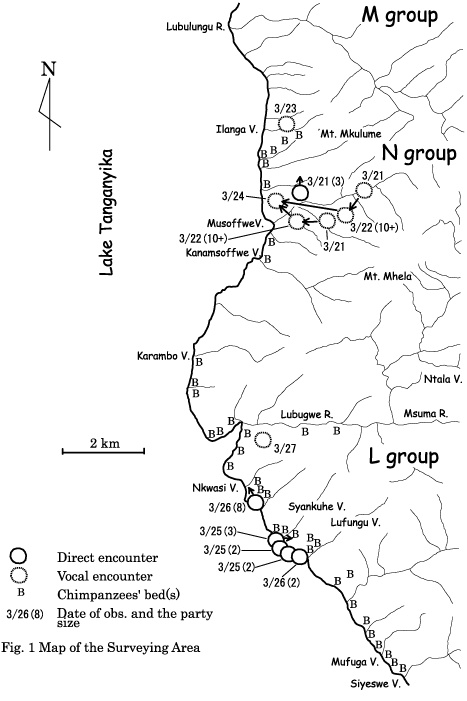|
A Note on the Southern Neighboring Groups of M group in the Mahale Mountains National Park
Masaki Shimada Graduate School of Science, Kyoto University, Kyoto, Japan
Introduction The M group is a well-habituated group of chimpanzees in Mahale that has become the main target of research and eco-tourism. In addition, the M group has several neighboring groups (1). Two of these neighboring groups to the south of the M group's range are called the N and L groups (1, 2). The range of the N group has been estimated to extend from lakeside to Mt. Mkulume and Mt. Mhela, and that of the L group extends over the Lubugwe, Msuma and Ntala Valleys. Because there has been no more information on those groups since the 1980s, it is difficult to estimate where and in which pattern they are ranging today.
It is important to immediately investigate the ranging areas and patterns of these neighboring groups. This would serve not only to understand the between-group relationships but also to provide basic information to use in habituating these chimpanzees for tourism and conservation in the future. We also trekked inland less than 2.5 km from the lakeside at Mt. Mkulume, Msoffwe Valley, Lubugwe River and the slope between Syankuhe and Lufungu Valleys. The area is mostly a steep slope covered with the Miombo woodland, which starts directly from the lake except for the riverine forest in some restricted areas along the valleys (2). Whenever we encountered chimpanzees, we recorded them with a digital video camera. We also recorded information on their beds, trodden paths, and eaten food items. New evidence (0-1day old) was used to estimate the movement of chimpanzee parties and old evidence (more than 2 days old) to estimate the range of each unit group.
Data on the M group during the survey was kept by the rest of the research staff. |

|
Direct and vocal encounter with the N group from March 21 to 24 (Fig. 1) shows a good example of their fission-fusion society in the late rainy season: Two parties, each including about 10 individuals (or more), and a party including two adult males and an estrous female separated on March 21, and then the two bigger parties chorused to each other on March 22. Although we did not observe them on March 23, the two parties seemed to join together and move to the north of the Msoffwe Valley on March 24. In addition, at least one other party existed in the north region of the Ilanga Valley on March 23, and they may have ranged independently. The estimated movements of the N group parties are shown in Fig. 1. As for the M group's ranging during the survey, a staff member directly observed a mother chimpanzee and her son only once on March 23 in the southern part of the M group's range. The observed food items of the L group were mainly leaves of Pterocarpus tinctorius and seeds of Diplorhynchus condylocarpon (Tables 1, 2). These are common varieties of woodland vegetation (2). Since such food is also used by the M group chimpanzees in the rainy season (Shimada, personal observation), it is likely that the L group chimpanzees normally use the lakeside area covered with the woodland in the same part of the year. These data suggest that it is a common phenomenon for all three unit groups to spread out widely in many small parties during the rainy season. |

|
Reaction to humans When we approached a party in the range of the N group on March 21, one of the males escaped silently as soon as he discovered us, and the others continued barking "Wraa" to us. On the other hand, as long as we observed from the boat, no chimpanzee of the L group seemed to be especially nervous about human observers. When I tried to land and approach three adults on March 25, one of the males hesitated to leave the feeding tree and looked at me for a few minutes. These observations gave us the impression that the L group chimpanzees were more habituated than the N group chimpanzees. The high frequency L group chimpanzees use a lakeside area in the late rainy season while humans pass by this area in boats. Consequently, we can assume that this situation facilitates more frequent encounters between chimpanzees and humans and, as a result, has already advanced the habituation process to some extent.
The study was supported by funds from MEXT Grants-in-Aid for Scientific Research (Basic Research A1, #12375003 to T. Nishida) and for the 21 Century COE Research (#A2 to T. Nishida).
Back to Contents |
